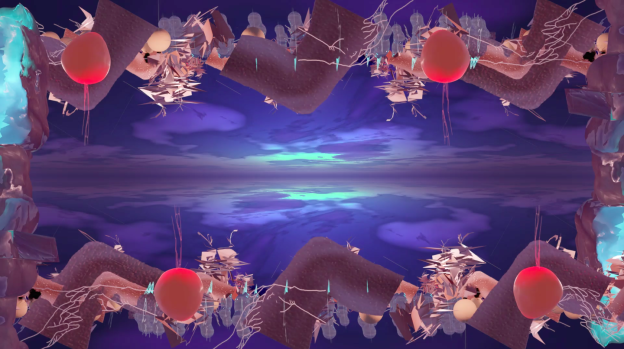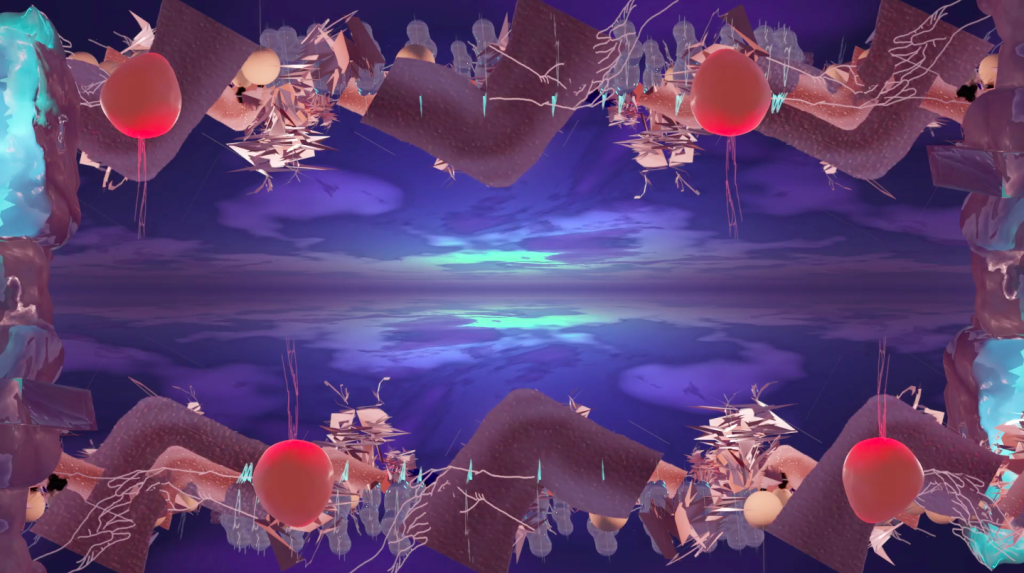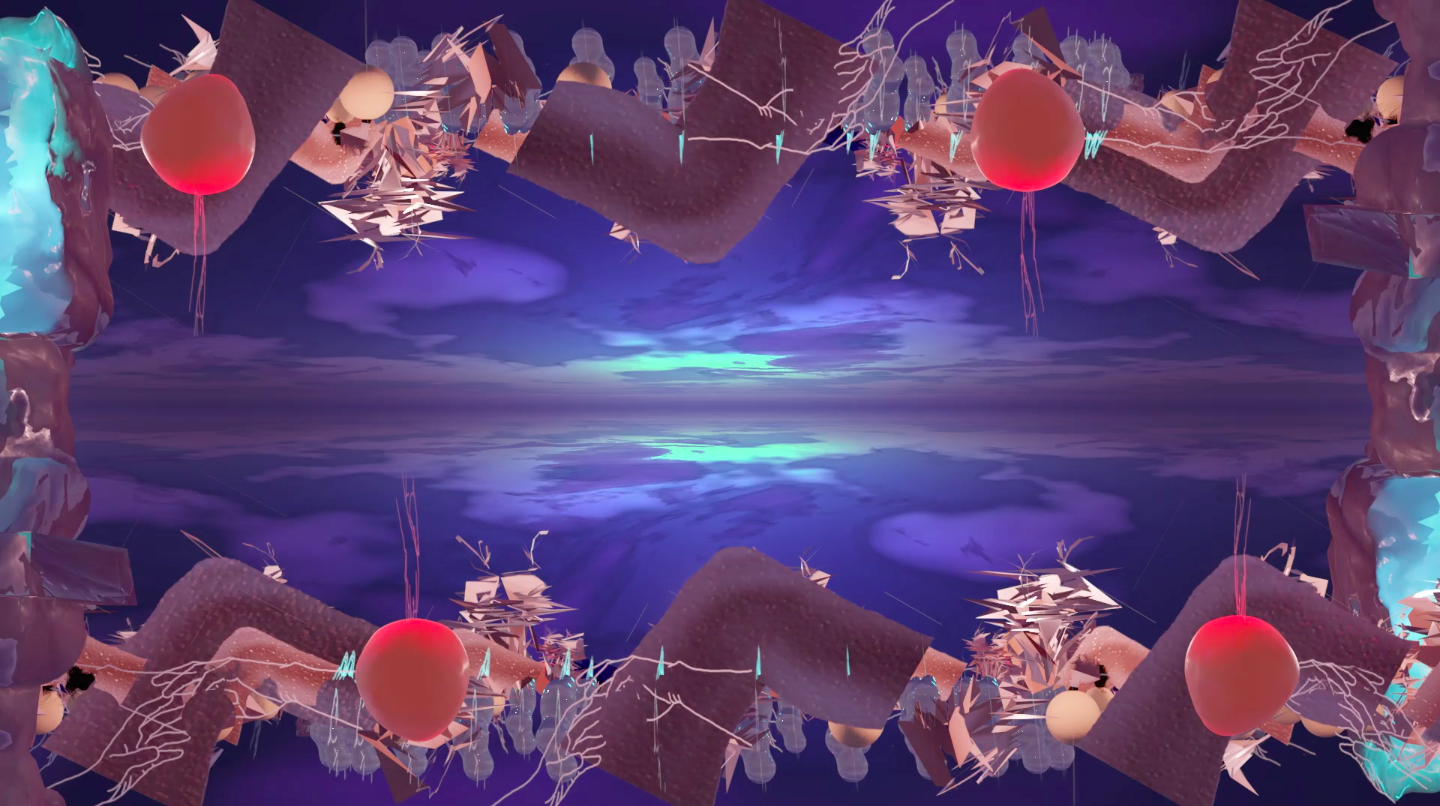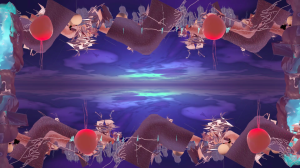
with GALAXY
a video by DAGMAR SCHÜRRER
“Time makes fossils of us all.”
—Tucker, a mammoth camper from Nintendo’s Animal Crossing: Pocket Camp (2020)
“For never has experience been contradicted more thoroughly than strategic experience by tactical warfare, economic experience by inflation, bodily experience by mechan-ical warfare, moral experience by those in power. A generation that had gone to school on a horse-drawn streetcar now stood under the open sky in a countryside in which nothing remained unchanged but the clouds, and beneath these clouds, in a field of force of destructive torrents and explosions, was the tiny, fragile human body.”
—Walter Benjamin, “The Storyteller: Reflections on the Works of Nikolai Leskov” (1936)
A ‘crossing’ happened after I had just discussed Isamu Noguchi’s 1947 work Monument for Men—a solemn photograph of colossal facial features protruding from flat, barren earth—in a Zoom lecture for the Whitney Museum of American Art: a visitor wrote in the chat box that Noguchi’s geometric simplification of facial forms reminds one of the facial designs for players in Animal Crossing, the video game that has become a cultural phenomenon since the COVID-19 pandemic started. I immediately saw it: the childlike and vaguely anthropomorphized face in Noguchi’s image—mouth lightly agape with a pyramid-shaped nose (that was to be a mile long according to the artist’s conception)—looks almost identical to those available in the game’s setup that sport similarly triangular noses. A deeper, art historical connection then emerges, as both appear to evoke the haniwa terracottas from Kofun period Japan (third to sixth century), which are funerary objects with a distinct and animated visual repertoire—cylindrical figurines with flailing arms, armored warriors, animals, small architecture. The hollow, gaping eyes and mouths often leave the impression of an innocent yet haunted expression, which, combined with their bid to the spiritual world, form a particularly poignant allegorical context for both Noguchi and Animal Crossing.
Created two years after the atomic bombings of Hiroshima and Nagasaki, Monument for Men was to be visible from space, commemorating mankind’s former home while broadcasting to extraterrestrial beings that intelligent life once existed on this planet. Et in Arcadia ego. Assuming a chilling, extra-human vantage point, Noguchi’s cosmic epitaph brackets humanity’s transient and volatile history by evoking its pre-Anthropocene moment, as in, the time before human activities’ irreversible dent on earth; it simultaneously reads as a relic marking civilizational endurance. As I’ve immersed myself in the smartphone version of Animal Crossing called Pocket Camp since June, I’ve come to appreciate its expansive, nuanced mode of allegories and survival. By this I don’t simply refer to its unprecedented role in sustaining affective and ludic spaces for engaging with other human players and the gameworld’s chatty animals, or its fascinating capacity for seemingly infinite possibilities for customizing one’s ideal digital habitats, all of which have indeed proven therapeutic during mass lockdowns, uncertainties, and injustice.
More crucially, its very mechanism of play engineers and cultivates curious resonances that reorient our sensibilities to time in all of its attendant ritualistic (be it agricultural, magical, or cultural), geological, and poetic rhythms. Many took note and revelled in the fact that Animal Crossing simulates synchronization with real time and space: at 5:00 p.m. my camp basks in gorgeous dusk hues; cicadas and sea urchins can only be captured in late summer; “market boxes” of players located in Japan would occasionally showcase fruits or fish species not available in my area; haunted willow trees and antique TV sets (where cursed spirits crawl out of static screens) become available to “craft” just in time for the Ghost Festival. Even for gamers such as myself who have experienced no shortage of sensational world-building in the virtual, Animal Crossing charms by relentlessly re-enchanting the real. Players certainly need not be conversant in zoological, regionally-cultural, or art historical knowledge to relish in the game’s multi-referential nebula, though for those who are, the joyous encounters with them—be it a Uluru model or a Super Mario pinball machine—make one feel particularly ‘seen’. The haniwas, for instance, enjoy full-fledged appropriation in the game, assuming various roles such as construction workers on Shovelstrike Quarry island or as “gyroidites,” which can be collected to craft special seasonable objects. As I’m writing this essay, they appear as flickering, translucent blue figurines—apt for the haunted theme in light of the upcoming Ghost Festival. Often the objects entice the players so much that they search for the references in online forums and game-specific wiki pages, which arguably makes rather effective cultural education.
In fact, Animal Crossing has provided quite the alternative platform for art during the prolonged lockdown and museum/theatre closures, garnering participation from established institutions. For example, the Metropolitan Museum and the Palace Museum in Taipei have both made collection masterpieces available for players’ private displays. New exhibitions and theater productions have also been staged. Talk about the (almost) democratization of art—almost free of the postcolonial guilt, geopolitical turmoil, or hefty insurance and production costs, among other physical limitations; inequality of access to digital technology notwithstanding. In 1964, Andy Warhol anticipated and claimed this moment with thirty black-and-white silk-screened Mona Lisas, on the occasion of the original work’s blockbuster reception in New York, titled Thirty are Better than One. Even when international travel and high-res digital images have long ceased to be things of novelty, tourists warming in front of the original Mona Lisa nowadays still feel compelled to outstretched their arms and take their own (often imperfect) snaps. This sense of ownership is potent: I have been giddy with the game’s integration of Jomon-period flameware—notable for the highly sculptural rims that imitate flares of fire—and a Tosa school golden screen in my wooden cabin for two months. They feel much more real to me than the posters in my apartment, as these art objects now occupy the same material (virtual) reality as my idiosyncratically furnished little shed in the game.
Yet compared to the museum collaborations, which certainly ameliorate the panicked rush to keep art spaces ‘open’ and art content afloat, I was much more drawn to the game’s inherently democratic approach to the integration of art content, and to its rich material culture in general, including both the non-player characters (more than two hundred anthropomorphized animals) and human players. In Animal Crossing: Pocket Camp, for instance, players encounter new animals as they venture to the beach or a forest to gather bugs, fruits, and fish in exchange for goods and construction materials. Upon inviting these animals to your camp, a list of desired objects associated with particular animals will pop up as the precondition for their visit: furniture of a particular style, plants, sports equipment, even art. When an elephant guest (there are several) requested antiquarian objects such as flameware or Stonehenge, it instantly clicked that he’s a mammoth who also appreciates ancient artifacts, which I found extremely endearing. The rationale for associating animals with their desired objects, their appearance and mannerism, or chosen garments are never homogenous, immediately transparent, nor limited to the canon of cuteness, which makes thinking about them a pleasurable little mental exercise. Some memorable ones include Pietro the clown-like sheep, Hopkins the air balloon bunny whose back reveals a clear plastic plug, and Ruby, who I only realized was the jade bunny from Chinese mythological tales when she requested me to craft the moon—her relationship to the moon clearly different from those animals who requested lunar rovers and space suits. The fact that a Rococo chair, a retro digital gadget like the Game Boy, and King Tut’s mask are jumbled in an unorganized and anachronistic playing field—where users freely (re)define their own relationship to them—illustrates perhaps the most radical premise of this game: its gentle, negentropic infrastructure. I think of Japan’s unique position and modernist trajectories such that its subcultures are at once locally specific and globally embraced, internalized.
Since the game synchronizes with real time, it also assumes a cyclical rather than a terminal dynamic of play. Narratives do not escalate to a final boss or battle but expand continuously, tuning our attention to the specific sprinkles of joy that, in my experience, clear little paths in a mental space too often shrouded in ambiguous, weighty malaise. At the same time, you do linearly accumulate animal friends (who always want to chat a bit), human ones (who visit your camp and buy from your market box), and a wealth of materials to furnish and create specific narrative spaces. The game encourages taking snapshots whenever significant new changes have occurred at the campsite; scrolling through a mere three months’ worth of different arrangements and décor at my own ever evolving camp felt like revising a parallel life lived digitally yet no less concretely.
An amusing cultural byproduct of the game’s recent popularity has been the anthropological and ideological interpretations of how players have engaged with various features and digital beings in the game. Obligatory Marxist meme accounts dedicated to the franchise appeared on Instagram; so did articles pointing out its innate settler colonialism; others discuss potentially disturbing sights of a rooster camper grilling meat at the camp’s BBQ facilities, or the relative likability of animals based purely on their appearances. In the New Horizons version of the game (currently the most popular version and playable only on the Switch consoles), some players intentionally ignored or harassed animals they dislike in order to make room for more popular characters to arrive; others become low-key devastated at the realization of their own cruelty, when the unwanted animals expressed sincere gratitude for the players’ hospitality and packed up to leave after days of cold-shoulder treatment. After all, when a game platform is open-ended and not explicitly didactic in its political correctness, it would of course reflect human whims and (de)morale.
While I’m not the least bit interested in moral sanctionings of video games, it did make me think of the affective dimensions we have yet to fully investigate and articulate, all while virtual living continues to intertwine with non-virtual lives—a process further accelerated during global pandemics. I think of those who ruminated over gestures of posting, not posting, or removing a black square from their Instagram feed; I think of my ghost Weibo account that was suspended back in February. I think of Ted Chiang’s novel The Lifecycle of Software Objects, where semi-sentient AIs (or “digients”) essentially resorted to machine learning and anthropomorphization for survival, and possibilities for a discourse of digital animism. I also think of the profoundly odd sensations of giving live webinars to an invisible yet large crowd for the Whitney Museum of Art titled “Art History from Home,” where the only optical feedback is my laptop against an apartment wall while the pressure of spontaneous speech acutely looms. I would become particularly depleted after sessions when I made particular efforts to illuminate (art) historical registers that have once again become poignantly resonant, like Noguchi’s post-Hiroshima sculptures of precariously balanced slabs. In these moments of depletion, I would log on to my camp and begin chatting with animals that gaze—sometimes accompanied with dance moves—earnestly and lovingly upon my presence.
GALAXY (2020)

The narrator in the moving image work GALAXY is technology itself. The story is generated by an algorithm and offers an interpretation of an encounter of love and disappointment, by telling about the brief meeting of the two characters Touch and Long Swipe. Small deviations in the language and the narrative logic reveal our social imprint of how stories are expected to be told and how technology is programmed to follow these perceptions. The mise en scéne is a computer-generated galaxy of objects and images reminiscent of the organic, but dismembered and fragmented, reflecting on the possibility of creating new worlds and stories in digital space by following a subjective system of ordering.
XIN WANG writer
Xin Wang is a Joan Tisch Teaching Fellow at the Whitney Museum and a Ph.D. candidate in modern and contemporary art at the Institute of Fine Arts, NYU. She is the curator of numerous exhibitions in the U.S., Europe, and Asia, and her latest writings have appeared in Art in America, Art Agenda, and Wallpaper (Chinese edition). She is currently planning an exhibition that explores Asian Futurisms for the Museum of Chinese in America in New York City.
DAGMAR SCHÜRRER artist
Dagmar Schürrer is a media artist based in Berlin, Germany. The digital image, found and generated, is her material to form a visual language beyond analogue perception, reflecting on the possibility of creating new worlds and stories in digital space by following a subjective system of ordering.
GALAXY (2020): Video with sound, 03:48min. Germany/Austria.
Dagmar’s work is also featured in Issue 005 alongside Mateusz Chmurski’s essay Make Poland Russia Again?
© Copyright for all texts published in Stillpoint Magazine are held by the authors thereof, and for all visual artworks by the visual artists thereof, effective from the year of publication. Stillpoint Magazine holds copyright to all additional images, branding, design and supplementary texts across stillpointmag.org as well as in additional social media profiles, digital platforms and print materials. All rights reserved.



